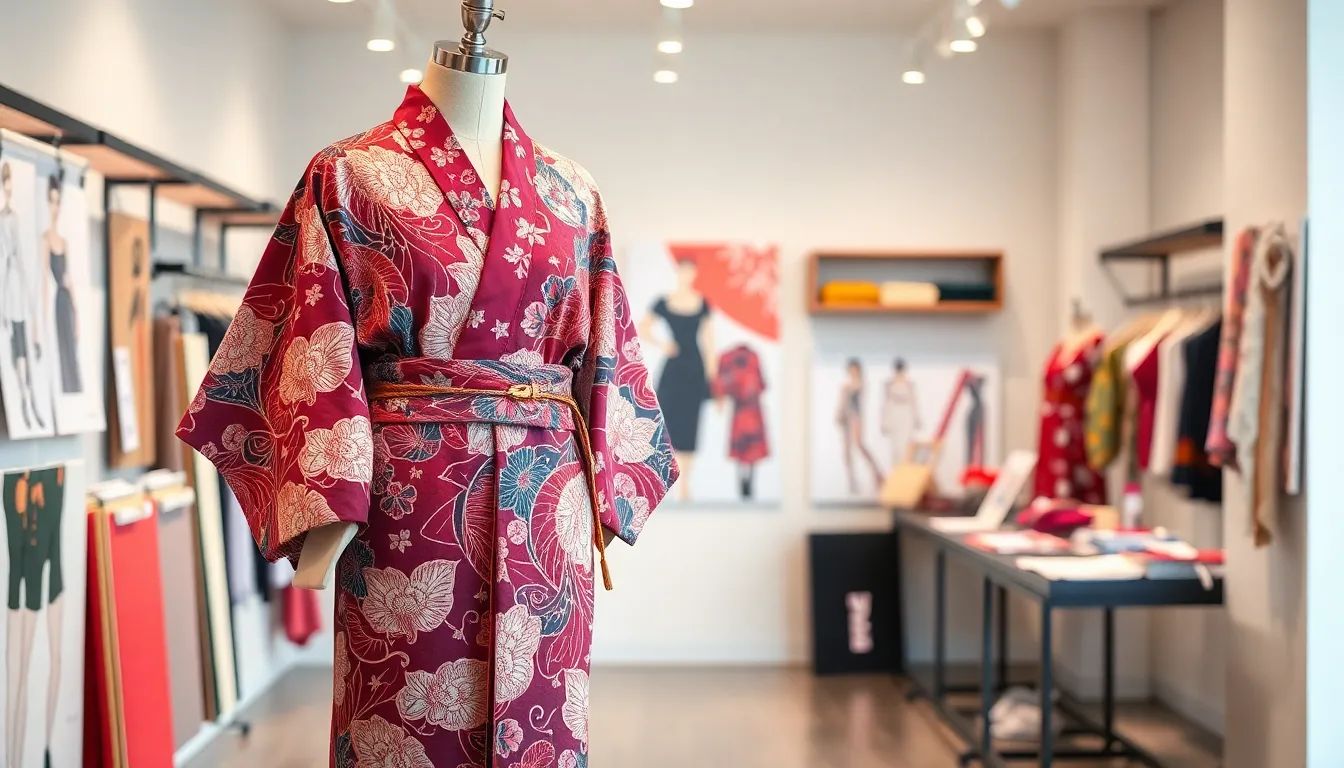Japanese formal wear isn’t just clothing; it’s a cultural experience wrapped in elegance and tradition. From the timeless kimono to the sharp lines of a Western-style suit, these garments tell stories of heritage and artistry. If you think formal wear is just about looking good, think again. It’s about making a statement, and in Japan, that statement often involves a splash of history and a dash of flair.
Japanese Formal Wear
Japanese formal wear embodies elegance and cultural significance, reflecting the nation’s rich heritage. Various garments illustrate how tradition impacts attire, revealing stories of artistry and personal expression.
Historical Significance
Japanese formal wear traces back centuries, embodying a deep connection to Japanese culture. Kimonos, once daily attire, became symbols of status and tradition. Different colors, patterns, and styles signified various occasions, from celebrations to solemn ceremonies. The Heian period significantly influenced kimono design, promoting lavish fabrics and intricate motifs. Furthermore, samurai wore specific garments to display rank and honor. Understanding this historical context enhances appreciation for Japanese formal wear, highlighting its transformative role in both social and cultural settings.
Modern Interpretations
Modern interpretations of Japanese formal wear showcase a blend of tradition and contemporary fashion. Designers often incorporate traditional elements into Western silhouettes, creating unique styles suitable for various occasions. Events like weddings feature modern kimonos that mix traditional aesthetics with innovative fabrics. Fashion shows frequently celebrate this fusion, emphasizing the adaptability of Japanese attire in a global context. Young adults increasingly embrace vibrant colors and modern cuts while honoring traditional roots. This evolution reflects both personal identity and cultural pride, ensuring that Japanese formal wear remains relevant and celebrated today.
Types of Japanese Formal Wear

Japanese formal wear embodies tradition and elegance, with various styles representing cultural significance. Each type offers insight into Japan’s rich heritage.
Traditional Attire
Kimonos serve as the quintessential traditional garment, worn during formal events and ceremonies. Fabrics like silk enhance their beauty, often featuring vibrant colors and intricate patterns that symbolize specific occasions. The furisode, characterized by its long sleeves, is primarily worn by young women during events like coming-of-age ceremonies. Men also wear kimonos, such as the montsuki, typically paired with hakama, a pleated trouser-like garment, during weddings or formal gatherings. Other garments, including the yukata, represent casual summertime wear yet can also appear at festivals. Layers are significant in traditional attire, often incorporating obi, decorative sashes that secure the kimono and add an element of sophistication. Each garment reflects unique cultural narratives and highlights the craftsmanship of Japanese artisans.
Contemporary Styles
Contemporary Japanese formal wear blends traditional aesthetics with modern influences, creating unique fashion statements. It reflects the evolving nature of cultural expression.
Western Influences
Western fashion significantly impacts contemporary Japanese formal wear. Designers often incorporate tailored silhouettes and modern fabrics into traditional designs. Fusion creates garments like the kimono jacket that pairs with Western trousers, offering versatility for various occasions. The adaptation of Western styles allows for personalized expression among wearers. Events like weddings now feature outfits that merge kimono elements with Western bridal attire. This integration showcases a dynamic design landscape that respects tradition while embracing change.
Fusion Designs
Fusion designs highlight the collaboration between Eastern and Western styles. Modern kimonos often blend traditional patterns with trendy cuts, making them suitable for diverse settings, including upscale events and fashion shows. Young designers experiment with prints and colors, infusing contemporary artistry into ancient techniques. Additionally, outfits like the modern yukata incorporate casual elements appealing to younger generations. The popularity of these styles signals a cultural shift, emphasizing creativity and individual expression within Japanese formal wear.
Occasions for Wearing Japanese Formal Wear
Japanese formal wear plays a vital role in various occasions, highlighting its cultural depth and significance. Events such as weddings, ceremonies, festivals, and cultural gatherings all showcase the beauty and artistry of these traditional garments.
Weddings and Ceremonies
Weddings in Japan often feature stunning formal wear like kimonos and montsuki. The bride typically wears a richly colored furisode, while the groom adorns a chic montsuki paired with hakama, creating a striking visual contrast. Traditional family ceremonies, such as shichi-go-san, also call for formal attire, where children dress in kimonos that reflect their age and gender. Each element within these outfits holds symbolic meaning, enhancing the overall experience of the celebration.
Festivals and Cultural Events
Festivals offer another opportunity to witness Japanese formal wear in action. During events like Hanami, attendees often opt for casual yukata, celebrating the beauty of nature, while formal kimonos appear during key performances or cultural demonstrations. Traditional dress enhances the vibrant atmosphere of these festivals, connecting participants to their heritage. Furthermore, regional festivals showcase unique patterns and designs, emphasizing local culture and identity through fashion.
Care and Maintenance
Maintaining Japanese formal wear requires careful attention to preserve its intricate beauty and cultural significance. Proper cleaning and storage ensure longevity and protect against damage.
Cleaning Techniques
Gentle cleaning methods work best for Japanese formal wear. Hand washing with cold water and mild detergent effectively removes dirt without damaging fabrics. Dry cleaning is suitable for items made from silk or delicate materials. Spot cleaning addresses minor stains while minimizing exposure to moisture. Fugitive dyes may bleed, so testing a small area before full application is recommended. Ironing can create wrinkles, so using a steamer is preferable. Avoiding harsh chemicals helps maintain color and texture.
Storage Tips
Proper storage plays a crucial role in preserving Japanese formal wear. Choosing breathable garment bags prevents moisture buildup and protects against dust. Hanging kimonos on padded hangers retains their shape and avoids creasing. Folding garments can minimize space use but should include protective layers, like acid-free tissue paper, between folds. Direct sunlight exposure can fade colors, so storing items in a dark, cool environment is essential. Regularly inspecting stored garments helps catch any potential issues before they become damaging.
Conclusion
Japanese formal wear stands as a testament to the country’s rich cultural heritage and artistic expression. It bridges the past and present by marrying traditional craftsmanship with modern design elements. Each garment tells a story, reflecting personal identity and cultural pride.
As fashion continues to evolve, the adaptability of Japanese formal wear ensures its relevance in today’s world. Whether it’s for weddings or cultural festivals, these garments remain a vital part of social and ceremonial life. By embracing both tradition and innovation, Japanese formal wear not only preserves history but also celebrates the creativity of contemporary design.





